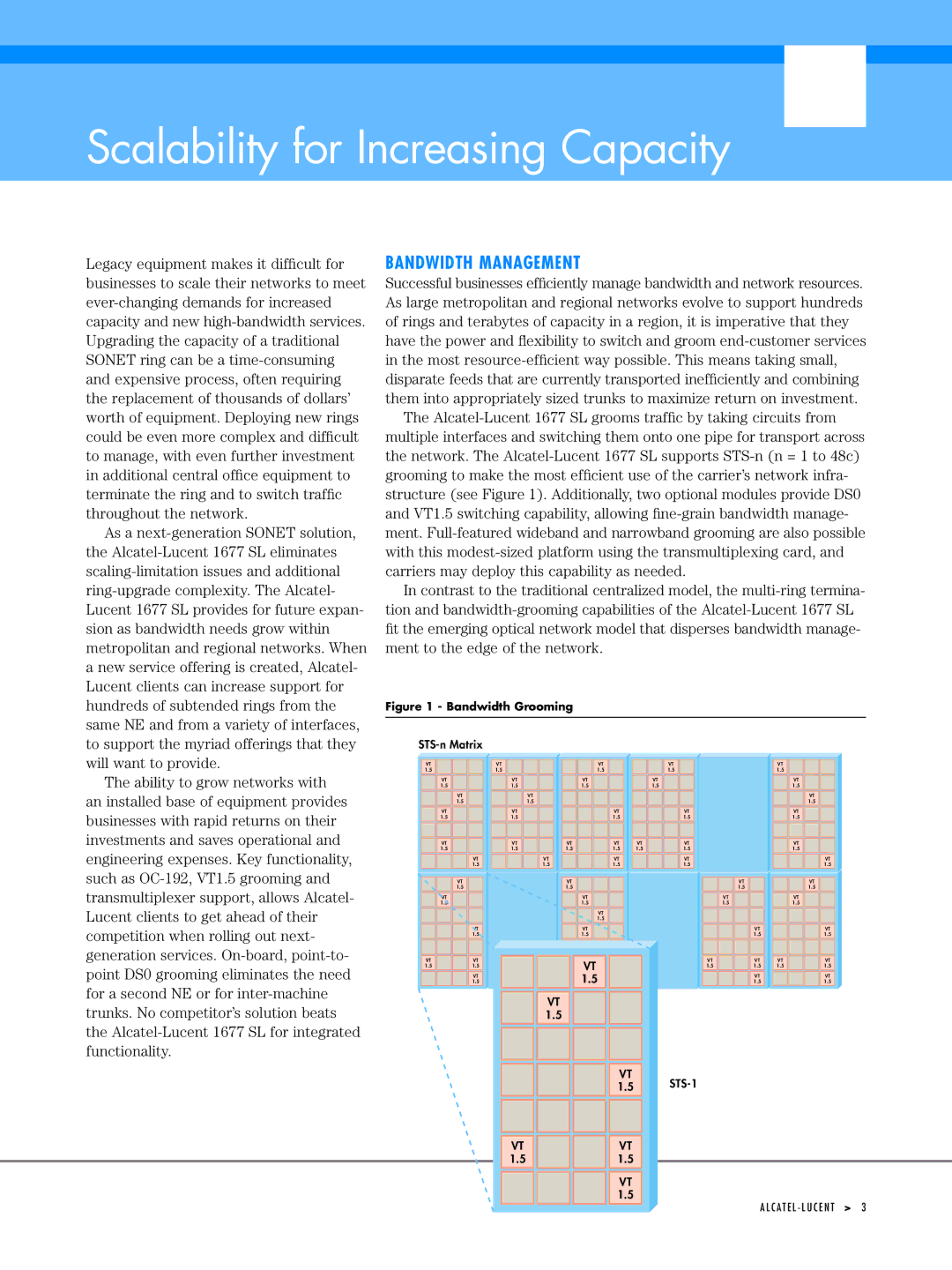Scalability for Increasing Capacity
Legacy equipment makes it difficult for businesses to scale their networks to meet ever-changing demands for increased capacity and new high-bandwidth services. Upgrading the capacity of a traditional SONET ring can be a time-consuming and expensive process, often requiring the replacement of thousands of dollars’ worth of equipment. Deploying new rings could be even more complex and difficult to manage, with even further investment in additional central office equipment to terminate the ring and to switch traffic throughout the network.
As a next-generation SONET solution, the Alcatel-Lucent 1677 SL eliminates scaling-limitation issues and additional ring-upgrade complexity. The Alcatel- Lucent 1677 SL provides for future expan- sion as bandwidth needs grow within metropolitan and regional networks. When a new service offering is created, Alcatel- Lucent clients can increase support for hundreds of subtended rings from the same NE and from a variety of interfaces, to support the myriad offerings that they
BANDWIDTH MANAGEMENT
Successful businesses efficiently manage bandwidth and network resources. As large metropolitan and regional networks evolve to support hundreds of rings and terabytes of capacity in a region, it is imperative that they have the power and flexibility to switch and groom end-customer services in the most resource-efficient way possible. This means taking small, disparate feeds that are currently transported inefficiently and combining them into appropriately sized trunks to maximize return on investment.
The Alcatel-Lucent 1677 SL grooms traffic by taking circuits from multiple interfaces and switching them onto one pipe for transport across the network. The Alcatel-Lucent 1677 SL supports STS-n (n = 1 to 48c) grooming to make the most efficient use of the carrier’s network infra- structure (see Figure 1). Additionally, two optional modules provide DS0 and VT1.5 switching capability, allowing fine-grain bandwidth manage- ment. Full-featured wideband and narrowband grooming are also possible with this modest-sized platform using the transmultiplexing card, and carriers may deploy this capability as needed.
In contrast to the traditional centralized model, the multi-ring termina- tion and bandwidth-grooming capabilities of the Alcatel-Lucent 1677 SL fit the emerging optical network model that disperses bandwidth manage- ment to the edge of the network.
Figure 1 - Bandwidth Grooming
STS-n Matrix
will want to provide.
The ability to grow networks with an installed base of equipment provides businesses with rapid returns on their investments and saves operational and engineering expenses. Key functionality, such as OC-192, VT1.5 grooming and transmultiplexer support, allows Alcatel- Lucent clients to get ahead of their competition when rolling out next- generation services. On-board, point-to- point DS0 grooming eliminates the need for a second NE or for inter-machine trunks. No competitor’s solution beats the Alcatel-Lucent 1677 SL for integrated functionality.
VT
1.5
VT
1.5
VT
1.5
VT
1.5
VT
1.5
VT
1.5
VT
1.5
VT
1.5
1.51.5
VT
1.5
VT | VT |
1.5 | 1.5 |
VT | VT |
1.5 | 1.5 |
| VT |
| 1.5 |
VT | |
1.5 | |
VT | VT |
1.5 | 1.5 |
| VT |
| 1.5 |
| VT |
| 1.5 |
| VT |
| 1.5 |
| VT |
| 1.5 |
| VT |
| 1.5 |
| VT |
| VT |
| 1.5 |
| 1.5 |
| VT |
| 1.5 |
| | VT |
| | 1.5 |
| | VT |
| | 1.5 |
VT | | VT |
1.5 | | 1.5 |
VT | VT | VT |
1.5 | 1.5 | 1.5 |
VT | | VT |
1.5 | | 1.5 |
VT | | |
1.5 | | |
VT
1.5
VT
1.5
VT VT
1.51.5
VT
1.5
VT
1.5
VT
1.5
VT
1.5
VT
1.5
VT
1.5
VT
1.5
VT
1.5
VT
1.5
VT
1.5
VT
1.5
VT
1.5STS-1
1.51.5
VT
1.5
A L C A T E L - L U C E N T > 3

